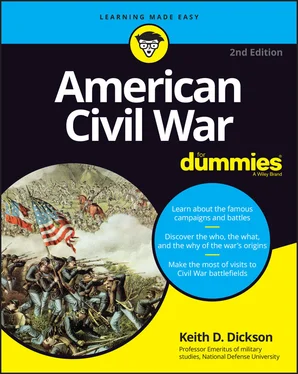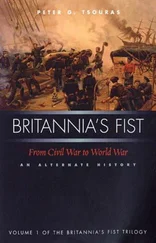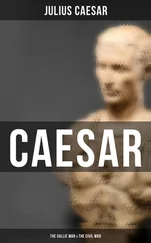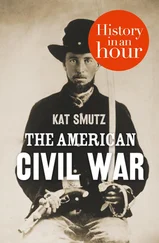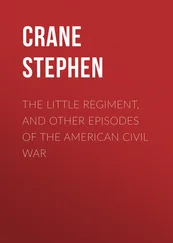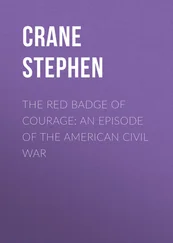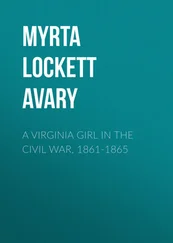Keith D. Dickson - American Civil War For Dummies
Здесь есть возможность читать онлайн «Keith D. Dickson - American Civil War For Dummies» — ознакомительный отрывок электронной книги совершенно бесплатно, а после прочтения отрывка купить полную версию. В некоторых случаях можно слушать аудио, скачать через торрент в формате fb2 и присутствует краткое содержание. Жанр: unrecognised, на английском языке. Описание произведения, (предисловие) а так же отзывы посетителей доступны на портале библиотеки ЛибКат.
- Название:American Civil War For Dummies
- Автор:
- Жанр:
- Год:неизвестен
- ISBN:нет данных
- Рейтинг книги:4 / 5. Голосов: 1
-
Избранное:Добавить в избранное
- Отзывы:
-
Ваша оценка:
- 80
- 1
- 2
- 3
- 4
- 5
American Civil War For Dummies: краткое содержание, описание и аннотация
Предлагаем к чтению аннотацию, описание, краткое содержание или предисловие (зависит от того, что написал сам автор книги «American Civil War For Dummies»). Если вы не нашли необходимую информацию о книге — напишите в комментариях, мы постараемся отыскать её.
American Civil War For Dummies,
American Civil War For Dummies
American Civil War For Dummies — читать онлайн ознакомительный отрывок
Ниже представлен текст книги, разбитый по страницам. Система сохранения места последней прочитанной страницы, позволяет с удобством читать онлайн бесплатно книгу «American Civil War For Dummies», без необходимости каждый раз заново искать на чём Вы остановились. Поставьте закладку, и сможете в любой момент перейти на страницу, на которой закончили чтение.
Интервал:
Закладка:
8 Part 4: War to the Hilt, 1863–1865 Chapter 17: The Battle of Chancellorsville, May 1863 Beginning a New Campaign in the Eastern Theater Heroes and Goats Chapter 18: The Battles of Gettysburg and Vicksburg, July 1863 The Gettysburg Campaign The Battle of Gettysburg: Day One The Battle of Gettysburg: Day Two The Battle of Gettysburg: Day Three The Final Moves The Battle’s Significance Heroes and Goats 1863: The Western Theater The Vicksburg Campaign The Siege and Fall of Vicksburg Success at Port Hudson Grant’s Accomplishment Heroes Goats Chapter 19: The Battles of Chickamauga and Chattanooga, August–November 1863 Rosecrans: Approaching and Taking Chattanooga The Chickamauga Campaign The Battle of Chickamauga: Day One The Battle of Chickamauga: Day Two The Battle Ends Chickamauga: The Results Heroes and Goats Turned Tables at Chattanooga The Battle’s Aftermath Heroes and Goats Chapter 20: Lee and Grant: Operations in Virginia, May–October 1864 Generals Get Their Orders from Grant Day One in the Wilderness: “Bushwhacking on a Grand Scale” Day Two in the Wilderness: Grant Doesn’t Quit Lee Loses the Initiative at North Anna Grant’s Disaster at Cold Harbor The Jug-Handle Movement to Petersburg The Second Valley Campaign The Siege at Petersburg: July–October 1864 Chapter 21: The Atlanta Campaign and a Guarantee of Union Victory, May–December 1864 Taking Command: Johnston and the Army of Tennessee Preparing to Move: Sherman in the Western Theater The Campaign for Atlanta Begins The Battle for Atlanta Looking at the Navy’s Contributions in 1864 Checking on Presidential Politics of 1864 Sherman’s March to the Sea Assessing Sherman’s Impact Chapter 22: The Destruction of Hood’s Army in Tennessee, October 1864–January 1865 Hood Moves North Triumphing at Nashville: Thomas’s Brilliant Plan The Battle of Nashville The Aftermath Heroes and Goats Chapter 23: A Matter of Time: Petersburg to Appomattox, January–April 1865 The Strategic Situation in 1865 Lee’s Fateful Dilemma: Petersburg The Last Retreat Symbolic Formalities: The Last Act Closing Events: The War Ends, a President Dies Victory and Uncertainty: The Reunited States Winners and Losers: The Debate Lives On
9 Part 5: Behind the Lines Chapter 24: The Confederacy: Creating a Nation at War Examining Jefferson Davis as President and War Leader Creating the New Confederate Government Financing the War Supplying Manpower for the War Supplying Material for the War Detailing the Confederate Naval War Struggling with Diplomacy: European Recognition Creating a Nation: Confederate Nationalism Chapter 25: The Union at War: Creating a New Republican Future for America Looking at Abraham Lincoln as President and War Leader Financing the War Running the War: Congress and the President Fighting the War Building an Economy: Northern Industrial Production Chapter 26: Wartime in America: Its Effect on the People Meeting the Common Soldier: Everyman Changing Women’s Roles in the Civil War Taking Note of the African American Contribution Discovering the American Indians
10 Part 6: The Civil War Tourist Chapter 27: Getting Ready to Travel Planning Your Trip Using Your Time Wisely Taking Three Methods on a Battlefield Chapter 28: Visiting a Civil War Battlefield Fine-Tuning Your Trip Getting Oriented: The Visitor Center Appreciating the Terrain Studying, Stories, and Reflection
11 Part 7: The Part of Tens Chapter 29: The Ten Worst Generals of the Civil War Braxton Bragg (1817–1876) Nathaniel P. Banks (1816–1894) Ambrose E. Burnside (1824–1881) John B. Hood (1831–1879) John B. Floyd (1806–1863) Benjamin F. Butler (1818–1893) Leonidas (Bishop) Polk (1806–1864) Joseph Hooker (1814–1879) John Pope (1822–1892) P.G.T. Beauregard (1818–1893) George B. McClellan (1826–1885): Honorable Mention Chapter 30: The Ten Biggest “Firsts” of the Civil War The Growing Dominance of the Defense Minesweeping: Naval Mines Starting Undersea Warfare: The Submarine Changing Tactics and Moving Quickly: The Railroad Battling without Bullets: Psychological Warfare Using Air-to-Ground Communication Dominating the Seas: The Ironclad Warship Talking over Wires: The Telegraph Increasing Firepower: The Repeating Rifle Born in the Civil War: The Machine Gun Chapter 31: The Ten Biggest “What Ifs” of the Civil War What If the Confederates Had Pursued After Manassas (Bull Run)? What If Grant Had Been Killed at Shiloh? What If Fort Sumter Had Not Been Fired On? What If McClellan Had Not Found Lee’s Lost Orders? What If McClellan Had Won Decisively at Antietam? What If Johnston Had Not Been Wounded at Seven Pines? What If Davis Had Adopted a Different Strategy in the West? What If Lee Had Won at Gettysburg? What If Davis Had Relieved Bragg Earlier in the War? What If Jackson Had Not Been Lost to Lee and the Army of Northern Virginia? Chapter 32: The Ten+ Best Battlefields of the Civil War and How to Visit Them Best Battlefields by the Mounted Method Best Battlefields by the Mounted/Dismounted Method Best Battlefields by the Terrain Walk Method
12 Index
13 About the Author
14 Advertisement Page
15 Connect with Dummies
16 End User License Agreement
List of Tables
1 Chapter 4 TABLE 4-1 Army Structure TABLE 4-2 Army Hierarchy and Command
2 Chapter 5 TABLE 5-1: Distribution of Major War Resources
List of Illustrations
1 Chapter 2FIGURE 2-1: Abraham Lincoln, Republican Party spokesman and future presidential...
2 Chapter 3FIGURE 3-1: The firing on Fort Sumter.
3 Chapter 4FIGURE 4-1: Interior and exterior lines. FIGURE 4-2: 1st Virginia Cavalry.FIGURE 4-3: The 12pd Napoleon — the standard artillery piece of both armies. FIGURE 4-4: Infantrymen of the 6th Massachusetts Volunteer Militia.
4 Chapter 7FIGURE 7-1: Cavalry troops with carbines.
5 Chapter 8FIGURE 8-1: Major General Irvin McDowell. FIGURE 8-2: General P.G.T Beauregard. FIGURE 8-3: Map of the battle of First Manassas (Bull Run).
6 Chapter 9FIGURE 9-1: Albert Sidney Johnston. FIGURE 9-2: U.S. Grant. FIGURE 9-3: Map showing the area around the Cumberland and Tennessee rivers. FIGURE 9-4: Union transports on the Tennessee River. FIGURE 9-5: Map of the battlefield of Shiloh.
7 Chapter 10FIGURE 10-1: Union General George B. McClellan. FIGURE 10-2: Admiral David G. Farragut. FIGURE 10-3: Map of the Peninsula Campaign. FIGURE 10-4: Franklin Buchanan, Commander of the CSS Virginia. FIGURE 10-5: USS Monitor (July 1862). FIGURE 10-6: Joseph E. Johnston.
8 Chapter 11FIGURE 11-1: Thomas J. (Stonewall) Jackson.
9 Chapter 12FIGURE 12-1: Robert E. Lee. FIGURE 12-2: Jeb Stuart. FIGURE 12-3: Scene from the Seven Days Battles.
10 Chapter 13FIGURE 13-1: John Pope. FIGURE 13-2: James Longstreet. FIGURE 13-3: Battle of Second Manassas.
11 Chapter 14FIGURE 14-1: Map of the Battle of Antietam. FIGURE 14-2: The Battle of Antietam — Burnside’s Bridge.
12 Chapter 15FIGURE 15-1: Map of Kentucky and Tennessee. FIGURE 15-2: Don Carlos Buell. FIGURE 15-3: Braxton Bragg.
13 Chapter 16FIGURE 16-1: Ambrose E. Burnside. FIGURE 16-2: Confederate soldiers at the stone wall at Fredericksburg. FIGURE 16-3: Nathan Bedford Forrest. FIGURE 16-4: General William S. Rosecrans.
14 Chapter 17FIGURE 17-1: Joseph Hooker.
15 Chapter 18FIGURE 18-1: A.P. Hill. FIGURE 18-2: Richard Ewell. FIGURE 18-3: George G. Meade. FIGURE 18-4: Winfield Scott Hancock. FIGURE 18-5: A scene from the battle of Gettysburg. FIGURE 18-6: Map of the Battle of Gettysburg. FIGURE 18-7: Map of the Battle of Vicksburg. FIGURE 18-8: David Dixon Porter.
16 Chapter 19FIGURE 19-1: Map of the Battles of Chickamauga and Chattanooga. FIGURE 19-2: George H. Thomas. FIGURE 19-3: The Battle of Chickamauga.
17 Chapter 20FIGURE 20-1: Battle of the Wilderness: Soldiers of the Union Army’s II Corps (n...FIGURE 20-2: Battle of Spotsylvania. FIGURE 20-3: Jubal Early. FIGURE 20-4: Philip Sheridan. FIGURE 20-5: Map showing Union and Confederate forts established during the sie...FIGURE 20-6: Bombproofs at Petersburg 1864. FIGURE 20-7: Battle of the Crater.
Читать дальшеИнтервал:
Закладка:
Похожие книги на «American Civil War For Dummies»
Представляем Вашему вниманию похожие книги на «American Civil War For Dummies» списком для выбора. Мы отобрали схожую по названию и смыслу литературу в надежде предоставить читателям больше вариантов отыскать новые, интересные, ещё непрочитанные произведения.
Обсуждение, отзывы о книге «American Civil War For Dummies» и просто собственные мнения читателей. Оставьте ваши комментарии, напишите, что Вы думаете о произведении, его смысле или главных героях. Укажите что конкретно понравилось, а что нет, и почему Вы так считаете.
